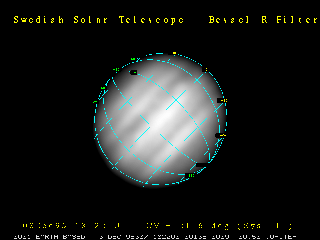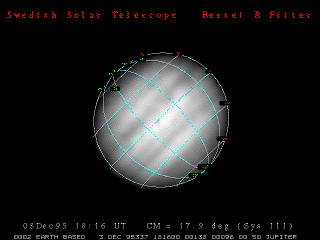 30K
30K
Since it is useful to know the kind of cloud environment the Galileo Probe is likely to sample on December 7, 1995, the imaging of Jupiter from earth based telescopes is desirable. However, imaging of Jupiter in November and early December is not easy due to its proximity to the Sun. Indeed, much of the observing will have to be performed during the day. The Hubble Space Telescope cannot point to an object if the sun angle is less than 45 degrees. On December 7, Jupiter is only about 9 degrees away from the Sun. In this context, the availability of the Solar Telescope of the Swedish Royal Academy of Sciences on the island of La Palma, Canary Islands is particularly attractive.
 31K
31K
Composite of 5 Bessel R filter images taken at about 18:16 UT on December 3, 1995. The image has been Fourier filtered to remove quanitzation noise.
Composite of 10 Bessel R filter images taken at about 18:22 UT on December 3, 1995. The image has been Fourier filtered to remove quanitzation noise.
Composite of 5 Bessel R filter images taken at about 18:22UT on December 3, 1995. The image has been Fourier filtered to remove quanitzation noise.
This image is a composite of 8 images taken through the 750 nm filter (10 nm bandpass) between 18:18:00 and 18:20:00 UT on December 4, 1995. Taken when Jupiter was about 7 degrees above the horizon, these images are among the last ones taken from the Swedish Solar Telescope. Continuous stratus cloud formation due to persistent northerly winds precluded any useful observations for the next five days.
This image taken with 800 ms exposure through a 5nm bandpass at 750 nm central wavelength filter at about 12:25 UT on December 4, 1995 shows the Galileo Probe Entry Site near the limb on the left as marked.
S.S. Limaye, Johan Warell (Uppsala Astronomical Observatory, Sweden) and Uri Carsenty (DLR, Germany) with the support of Prof. Goeran Scharmer (Stockholm Observatory, Sweden), Rolf Kever and Goran Hosinksy (Swedish Solar Vacuum Tube Telescope, La Palma)